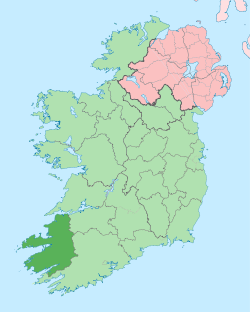Fahamore
Fahamore (Irish: An Fhaiche Mhór, meaning "the large green") is a small hamlet/village on the Maharees peninsula in County Kerry. It consists of about 50 houses and one famous pub, Spillane's.[1] Fahamore was historically much larger than it is now as evidenced by two old schoolhouses in the village, one dating from 1849 and the other from 1911. Fahamore is located on the shore of Brandon Bay and is a centre for diving, surfing, windsurfing and sea bass fishing.
Fahamore is also a centre for currach (or Naomhóg) building in the home of master currach builder Monty O'Leary. Currachs are still used as both fishing boats and trawler tenders in Fahamore at the local fishing harbour located on Scraggane Bay. Fahamore hosts a currach racing regatta every July where teams from the western seaboard of Ireland (from Kerry to Galway) compete in the All-Ireland Currach racing series.
History
The cliff face at Fahamore has extensive evidence of prehistoric settlement in the form of shell middens - a survey of the middens can be found in the book "Archaeological Survey of the Dingle Peninsula".[2]
The Night of the Big Wind - local oral histories tell of a night in 1839 when there was a particularly bad storm.
A three masted sailing ship, the Charger, carrying a cargo of deal,[3] was wrecked in Carralougha in 1890 - the remains of the ship's boilers are still in evidence on the rocks near Fahamore at low tide.
A sea wall was built, probably in the 19th century, to prevent coastal erosion - it had limited success, as it now lies in pieces about 20m from the cliff edge - in the 1990s rock armour was put in place by Kerry County Council to protect the coast from Fahamore southwards for a distance of about two kilometers.
A comprehensive list of local placenames and their origins is contained in the book "Triocha Cead Corca Dhuibhne" by An Seabhac. The real meaning of Fahamore is the 'Big Green' i.e. a reference to the big open green area in front of Spillane's bar.
Geography
Villages near Fahamore (i.e. on the Maharees peninsula) include Cutteen, Garrywilliam, Barr na Duiche, Ceann Duiche and Kilshanig. Access to the beach at Brandon Bay is via the Point Gap and Maherabeg Cut.
Economy
Fishing
The pier at Fahamore (situated on the western side of Scraggane Bay) is used extensively during the summer months by the local fishing fleet, which consists of around 20 half-decked and decked boats in the range 7–15 metres. Species fished include the European lobster (Homarus gammarus), spiny lobster or crayfish, spider crab, edible crab, and Atlantic salmon (Salmo salar). In the winter there is a managed fishery in Tralee Bay for the European oyster (Ostrea edulis).
Fishing methods include pots and tangle nets for crabs, lobsters and crayfish and monofilament drift nets for salmon. Shellfish are typically stored in large wooden "storeboxes", which are moored in Scraggane Bay, until the day of selling, when they are transferred to "vivier" trucks for live export to Spain and France.
Agriculture
The fields around Fahamore are extensively cultivated with vegetables including carrots, parsnips, swedes and onions, which thrive in the sandy soil. There has is also some dairying activity and raising of cattle for beef.
Tourism
Tourism is a major contributor to the local economy, through holiday home rentals, pubs and restaurants, surfing, windsurfing, scuba diving, walking and sea angling.
Aquaculture
The "fish pond" at Kilshanig, which was originally intended to store lobsters, is now used as an abalone farm.
Flora and fauna
Rabbits abound around Fahamore, as do rats, mice and the odd fox and badger. Local birds include seabirds (several species of seagull, shags, cormorants, gannets to name but a few), larks, starlings, curlews, crows, ravens, garden birds such as sparrows, robins and finches, and wading birds such as the heron. The swallow is a frequent visitor in the summer months. Marine mammals including seals and dolphins are frequently seen. Fish include sea bass, mullet, pollack, wrasse, dogfish, sea trout, flounder, plaice and ray. Shellfish found in the intertidal zone at Fahamore include mussels, limpets, periwinkles and whelks, as well as several species of crab, including shore, velvet and hermit. Lugworms are found extensively in the sand and their casts may be seen at low tide. They are frequently dug by local anglers and used as bait for bass fishing. Seaweeds include kelp, several varieties of wrack (including bladder and serrated), dilisc (or dulse), agar, sea grass, sea lettuce and carrageen moss.
See also
References
External links
- Fahamore weather conditions (courtesy of Rik's Windsurfing)
- Directions for visiting sailing vessels
Coordinates: 52°18′N 10°03′W / 52.300°N 10.050°W
